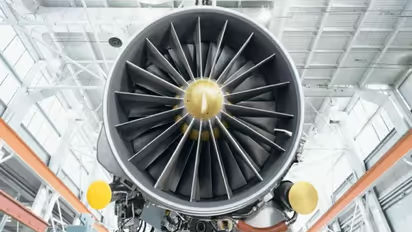PM Modi's US Visit: Landmark GE-414 jet engine deal awaits in Washington

Synopsis
Authorities in the United States are looking to grant General Electric (GE) authorization to construct jet engines for India's military aircraft in India. The agreement's particulars have been finalized through negotiations, yet it awaits approval from the US Congress before progressing. Girish Linganna reports
On June 22, 2023, accompanied by Prime Minister Narendra Modi, United States President Joe Biden is expected to announce a pact between the two countries. Negotiations have been completed concerning the details of the agreement, but it is still awaiting the green light from the US Congress. Hindustan Aeronautics, a public aerospace and defence firm owned by the Indian government, had declared their plan to utilize 414 engines designed by GE for the development of military aircraft. New Delhi wishes to receive engine manufacturing technology from India.
On May 18, the Pentagon revealed that the joint production of fighter engines, long-range cannons, and infantry combat vehicles between the United States and India would beef up the relationship between the defence industries of Washington and New Delhi.
The department stated that Deputy Secretary of Defence Kathleen Hicks and Indian Defence Secretary Giridhar Aramane had a meeting at the Pentagon on this same day. They deliberated on the "priorities in deepening the defence partnership" between both countries and augmenting 'cooperation in the defence industry field'.
In 1986, India started to strive towards developing their own aircraft with a locally made engine. This was ultimately unsuccessful as the Kaveri engine did not fit the criteria. Nine models were built and a lot of resources were utilized, but it was all for nought. Consequently, the first indigenous fighter Tejas that was adopted by the Indian Air Force in 2016 was fitted with an imported GE F404 engine.
Besides, the Tejas Mk 2, the Twin Engine Deck based Fighter (TEDBEF) and the Advanced Medium Combat Aircraft (AMCA) require a greater thrust, and the GE-414 can provide it. The GE is currently constructing the F414 EPE aircraft engine with a new core, a revised fan and a compressor, granting it a 20 per cent increase in a thrust up to 120KN. This engine is able to be employed in the AMCA project.
In 2010, GE was successful in obtaining a contract to provide 99 F414-INS6 engines for the Mk-2 LCA-Tejas with the possibility of an additional 40 being ordered. This variant has since been upgraded to a Medium Weight Fighter with a higher maximum take-off weight of 17.5 tonnes, and the GE representatives assert that an extra 18kn Wet Thrust should be beneficial for the MWF following modifications to its payload and armament potential.
The F414-GE-400 engine, belonging to the 22,000-pound class, is a General Electric afterburning turbofan. It has an axial compressor with three fan stages, seven high-pressure compressor stages, one high-pressure turbine stage, and one low-pressure turbine stage while weighing 2,445 pounds and having a thrust-to-weight ratio of 9.
The US Navy considers this engine to be one of the most modern and sophisticated available, as it is a combination of advanced technology and the already proven design of its predecessor, the F404.
This results in an engine that is resilient, reliable, and easy to service, providing the Boeing F/A-18E/F Super Hornet and the EA-18G Growler with 35% more thrust than the F404, thereby improving the aircraft's range, payload, and survivability.
By the start of next year, the Aeronautical Development Agency (ADA) will be revealing the LCA Mark II, whose propulsion is the India-specific GE-414 INS6 engine. It is anticipated that this aircraft will soar by 2024 and the power of the GE-414 can be increased if necessary.
The F414-GE-INS6 from the F414 family is the most advanced version available and is designed to meet the exacting requirements of India's Air Force and Naval services. This model boasts a variety of cutting-edge features, such as Full Authority Digital Electronic Control (FADEC) and additional safety measures for single-engine operations. Furthermore, its 98kN Class of Wet Thrust allows for powerful performances.
Manufacturing of the GE-414 engine will include 70-100 per cent technology transfer. This transfer of technology is expected, and General Electric holds the rights to the intellectual property. As a result, India will require the permission of the US in order to sell planes that have engines produced by them domestically.
The Biden administration has given the green light for General Electric to manufacture with TOT, thus creating a platform which can support collaborative design, development, and production between two nations of advanced engines with a thrust of over 110 kN.
China has manufactured a new powerplant for its J-20 fighter jet, which has addressed matters such as the overheating of blades, while India is still depending on engine technology from the United States and other countries. The WS-15 engine has been in the works for many years and is armed with single-crystal turbine blades on the cutting edge of technology. Photos of the J-10CEs deployed by the Pakistan Air Force show they are outfitted with Chinese-made WS-10 engines. However, with the GE-414, Indian aircraft will now have engines that are more reliable and fuel-efficient.
PM Modi's US Visit: State visit sends a special message
Stay updated with all the latest Business News, including market trends, Share Market News, stock updates, taxation, IPOs, banking, finance, real estate, savings, and investments. Track daily Gold Price changes, updates on DA Hike, and the latest developments on the 8th Pay Commission. Get in-depth analysis, expert opinions, and real-time updates to make informed financial decisions. Download the Asianet News Official App from the Android Play Store and iPhone App Store to stay ahead in business.